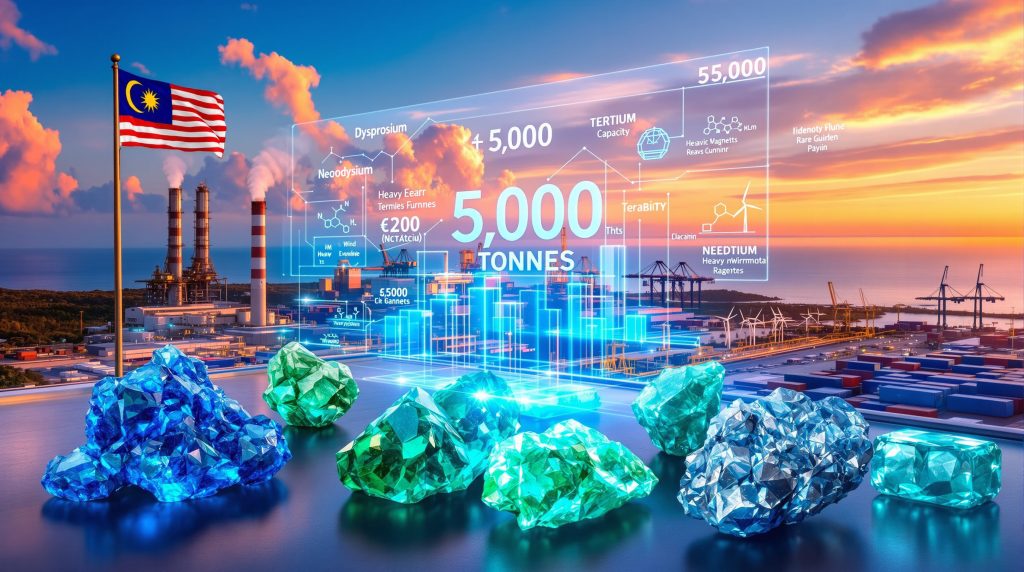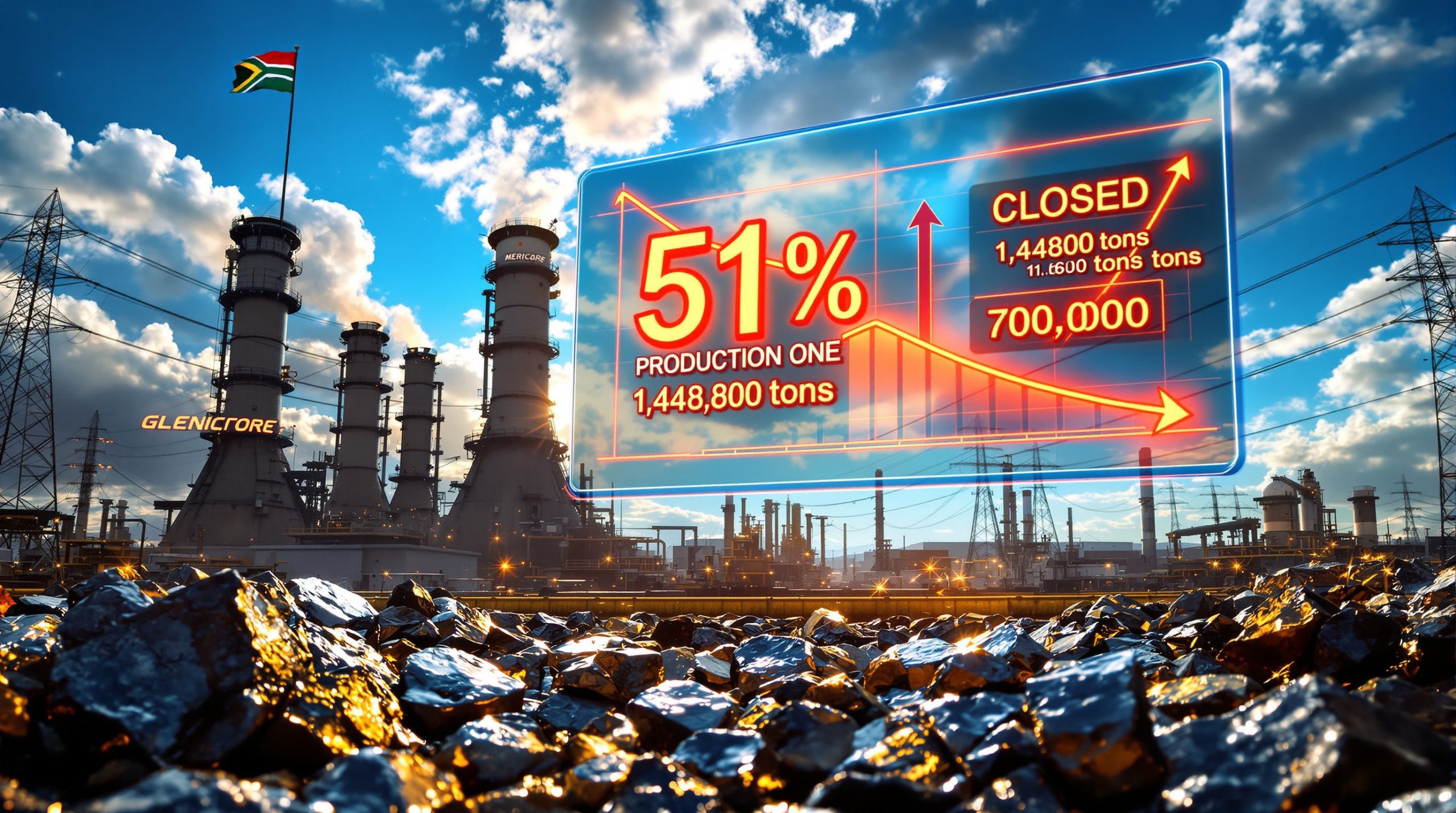The Lynas rare earth facility in Malaysia represents a pivotal development in global supply chain diversification, as Australia's Lynas Rare Earths announced a significant A$180 million investment (approximately $116.96 million USD) to establish a new heavy rare earth processing facility. This strategic move positions the company to strengthen its role as the world's largest rare earth producer outside China, addressing growing global demand for critical materials sourced beyond Chinese supply chains.
The announcement, made on October 28, 2025, represents a calculated response to increasing market pressures for supply chain diversification in the rare earth sector. The facility will focus specifically on heavy rare earth elements, which command premium pricing due to their scarcity and critical applications in advanced technologies.
The project timeline remains subject to regulatory approvals from Malaysian authorities, though Lynas has not disclosed specific construction milestones or completion dates. This regulatory pathway reflects the complex environmental and operational considerations inherent in rare earth processing operations.
Technical Specifications and Advanced Processing Capabilities
The new Malaysian facility will feature 5,000 tonnes per annum heavy rare earth separation capacity, representing a substantial expansion of Lynas' processing capabilities. This capacity targets the separation and refinement of heavy rare earth feedstock sourced primarily from the company's Mt Weld operations in Western Australia, supplemented by materials from other developing supply sources.
Heavy rare earth separation requires sophisticated processing methodologies, typically involving multi-stage solvent extraction techniques and precipitation processes. These elements, including dysprosium, terbium, and holmium, are significantly more challenging to separate and purify compared to light rare earth elements, requiring specialized chemical processing infrastructure.
The feedstock diversification strategy indicates Lynas' intention to reduce dependence on single-source materials, potentially incorporating rare earth concentrates from emerging mining projects across multiple jurisdictions. Furthermore, this approach enhances supply security while providing operational flexibility for the new facility.
Geographic Advantages and Industrial Integration
The facility will be located within Malaysia's Gebeng Industrial Estate, leveraging existing infrastructure and proximity to established industrial networks. This location provides strategic advantages for serving Asian manufacturing hubs while maintaining efficient logistics connections to global markets.
Malaysia's position as a rare earth processing hub offers several operational benefits:
- Port access for efficient import of feedstock and export of finished products
- Established industrial infrastructure reducing development costs
- Skilled workforce with experience in chemical processing operations
- Regulatory framework familiar with rare earth processing requirements
The Gebeng location also enables integration with Lynas' existing Malaysian operations, potentially creating operational synergies and shared infrastructure benefits that could enhance overall processing efficiency.
Critical Applications Driving Market Demand
Heavy rare earth elements serve essential functions across multiple high-growth technology sectors. Dysprosium and terbium are particularly critical for permanent magnet applications in electric vehicle motors and wind turbine generators, where they enhance magnetic strength and temperature stability.
The defense and aerospace sectors represent additional demand drivers, utilizing heavy rare earths in:
- Precision-guided munitions and advanced radar systems
- Satellite technology and communication equipment
- Advanced alloys for high-performance applications
- Electronic warfare and countermeasure systems
Market analysts project continued growth in heavy rare earth demand, driven primarily by the global transition to renewable energy systems and electric mobility. Wind turbines require approximately 200-600 kilograms of rare earth materials per megawatt of capacity, with heavy rare earths comprising a significant portion of these requirements.
Supply Chain Security and Western Strategic Interests
Lynas' expansion addresses growing concerns about rare earth supply concentration in Chinese operations, which currently control approximately 85-90% of global rare earth processing capacity. This dominance creates strategic vulnerabilities for Western nations dependent on these materials for defense and clean energy technologies.
The company is currently engaging with multiple offtake partners to secure long-term supply agreements for the facility's expanded product range. In addition, these discussions focus on establishing fair pricing mechanisms while ensuring supply security for critical applications.
Disclaimer: Market projections and supply chain assessments are subject to geopolitical developments, technological changes, and regulatory modifications that could significantly impact outcomes.
Western governments have identified rare earth supply diversification as a critical national security priority, leading to various policy initiatives supporting non-Chinese production capabilities. These include investment incentives, research funding, and strategic partnership frameworks designed to reduce supply chain vulnerabilities, particularly concerning the critical minerals energy transition.
Operational Scale and Production Capabilities
The Lynas rare earth facility in Malaysia represents a significant scale advantage in non-Chinese rare earth processing. The company's current and planned capabilities demonstrate substantial production capacity across multiple product categories:
| Product Category | Current Annual Capacity | Planned Enhancement |
|---|---|---|
| Neodymium-Praseodymium Oxides | 10,500+ tonnes | Maintained levels |
| Heavy REE Separates | 1,500 tonnes | Expansion to 5,000 tonnes |
| Processing Infrastructure | 100+ hectares | Additional facility development |
| Workforce | 300+ employees | Expansion planned |
The facility expansion represents approximately 233% increase in heavy rare earth processing capacity, positioning Lynas to capture a larger share of the premium heavy rare earth market. This capacity enhancement occurs alongside continued production of light rare earth products, creating a diversified product portfolio.
Environmental Standards and Processing Technology
Modern rare earth processing facilities must meet stringent environmental compliance requirements, particularly regarding waste water management and radioactive material handling. Heavy rare earth separation generates various chemical byproducts requiring careful treatment and disposal protocols.
Advanced processing methodologies typically employ:
- Multi-stage solvent extraction systems for element separation
- Precipitation and crystallization processes for purification
- Closed-loop water systems minimizing environmental impact
- Waste treatment facilities managing chemical residues
Malaysian environmental regulations require comprehensive impact assessments and ongoing monitoring of processing operations, ensuring compliance with international environmental standards while maintaining operational efficiency. However, this mirrors broader waste management solutions being implemented across the mining industry.
Investment Analysis and Financial Implications
The A$180 million capital expenditure represents a significant investment in rare earth processing infrastructure, reflecting confidence in long-term market demand and pricing stability. This investment level indicates substantial facility complexity and advanced processing capabilities.
Financial considerations include:
- Construction and infrastructure development costs
- Technology acquisition and installation expenses
- Regulatory compliance and environmental systems
- Working capital requirements for operations
Heavy rare earth products typically command premium pricing compared to light rare earth elements, with dysprosium oxide prices historically ranging from $350-500 per kilogram depending on market conditions and purity specifications.
Investment Disclaimer: Rare earth pricing is subject to significant volatility based on supply-demand dynamics, geopolitical factors, and technological developments. Past performance does not guarantee future results.
Revenue generation potential depends on successful execution of offtake agreements, operational efficiency achievement, and sustained market demand for heavy rare earth products across key application sectors.
Regulatory Pathway and Timeline Considerations
The facility development requires multiple regulatory approvals from Malaysian authorities, including:
- Environmental impact assessments and mitigation plans
- Industrial operating licenses and safety certifications
- Import-export permits for feedstock and product handling
- Waste management approvals and monitoring protocols
Lynas has not disclosed specific timeline expectations for these approvals, though similar projects typically require 12-18 months for comprehensive regulatory review. Construction and commissioning phases could add 24-36 months to the overall development timeline.
The company's existing Malaysian operations provide regulatory familiarity and established relationships with oversight authorities, potentially facilitating the approval process for the new facility. For instance, recent reporting indicates strong government support for the project.
Market Position and Competitive Advantages
Lynas' position as the largest non-Chinese rare earth producer provides significant competitive advantages in serving Western markets seeking supply chain diversification. The company's integrated operations, from mining through processing, offer cost advantages and supply security benefits.
Key competitive strengths include:
- Established customer relationships across multiple industries
- Proven processing capabilities with operational track record
- Strategic geographic positioning serving Asian and Western markets
- Regulatory compliance experience in multiple jurisdictions
The heavy rare earth focus targets the most valuable segment of the rare earth market, where Chinese dominance is most pronounced and Western supply alternatives are most critically needed. This aligns with broader mining industry innovation trends focused on strategic mineral production.
Future Expansion and Strategic Development
The Malaysian facility expansion represents part of Lynas' broader strategy to capture growing rare earth demand while serving customers seeking non-Chinese supply sources. The company's Mt Weld resource base in Western Australia provides substantial reserves supporting long-term production growth.
Potential future developments may include:
- Additional processing capacity expansions based on market demand
- Downstream product development for specialized applications
- Strategic partnerships with technology companies and government entities
- Research and development initiatives for processing efficiency improvements
Malaysia's role as a regional rare earth processing hub could expand significantly as global supply chain diversification efforts intensify, potentially attracting additional investment and infrastructure development. This development contributes to Australia's broader critical minerals reserve strategy.
Conclusion: Strengthening Critical Mineral Supply Security
Lynas' A$180 million investment in Malaysian heavy rare earth processing capabilities addresses critical supply chain vulnerabilities while positioning the company for growth in high-value rare earth products. The facility's 5,000 tonnes annual capacity represents substantial expansion of non-Chinese processing capabilities.
The project's success depends on regulatory approval achievement, successful offtake agreement negotiations, and sustained market demand for heavy rare earth products. However, the strategic importance of supply chain diversification and the premium nature of heavy rare earth applications suggest strong long-term demand fundamentals, particularly within the evolving geopolitical mining landscape.
Forward-Looking Disclaimer: This analysis contains forward-looking statements regarding market conditions, production capabilities, and investment outcomes. Actual results may differ materially due to various risk factors including regulatory changes, market volatility, and operational challenges.
Consequently, Malaysia's position as a critical minerals processing center continues to strengthen, supported by government policies and international partnerships focused on supply chain resilience. The Lynas rare earth facility in Malaysia represents a significant milestone in reducing Western dependence on Chinese rare earth processing capabilities while meeting growing demand from clean energy and defense technology sectors.
Looking to Capitalise on Critical Minerals Investment Opportunities?
Discovery Alert's proprietary Discovery IQ model delivers real-time alerts on significant ASX mineral discoveries, including critical minerals projects that could benefit from global supply chain diversification trends like Lynas' Malaysian expansion. Begin your 30-day free trial today and position yourself ahead of the market with instant notifications on actionable investment opportunities.




